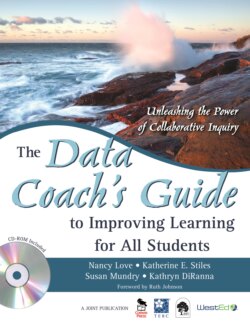Читать книгу The Data Coach's Guide to Improving Learning for All Students - Katherine E. Stiles - Страница 30
1 The Power of Collaborative Inquiry
ОглавлениеWhat the best and wisest parent wants for his own child, that must the community want for all of our children.
—John Dewey
Lea is a spunky fourth grader who loves geography, expressive writing, gymnastics, and her friends, but homework is a constant struggle for her.
Bethany loves gymnastics and is highly kinesthetic. She is catching up on her reading and, after some difficulty, is expected to be at grade level by the end of this year.
Brianna’s strength is her intelligence about nature; she can name and give great details about all the fauna and flora in the neighborhood. A seventh grader, she struggles in school and now attends a school for students with exceptional needs.
Jared is going into second grade. His strength is his sense of identity and what it means to be Navajo. He loves to draw; his challenge is reading. This past school year he had to work very hard on his reading skills.
Chinua just graduated from high school and received a full scholarship to Morehouse College. He is extremely bright and loves science and mathematics. He gets bored easily if he is not challenged.
We begin this book with images of children we know because they inspire us to do the work we do (see Figure 1.1). It could be so easy to get lost in the numbers—student identification numbers, scale scores, proficiency cut points (see Figure 1.2)—and forget that the numbers represent the hope and future of real children with strengths as well as challenges, each deserving the kind of education we want for our very own children (see Figure 1.3).
When asked what they would want for their own children, most educators inevitably say they expect the highest levels of education. Do other people’s children deserve any less?
—Johnson, 2002, p. 320
Figure 1.2
Figure 1.3
We care about data because we care about children learning and succeeding. Data can sound the alarm when someone is not learning and activate an immediate response. The data give us a powerful entrée into dialogue about the toughest issues, such as confronting how well our schools are working for all children and the inequitable practices that persist. They challenge and help us rethink basic assumptions. They hold a mirror up to instructional practice to pinpoint what is and is not working. Data help to set the right goals for action and, once changes are implemented, they provide constant feedback to guide mid-course corrections and monitor results.
Data also give us cause for celebration and opportunity to recognize teachers and students for a job well done. Using data to guide action is the most powerful lever we have to improve our schools; and yet, despite the increasing quantity now available, data are woefully underutilized as a force for change.
Schools are gathering more and more data, but having data available does not mean that data are used to guide instructional improvement. Many schools lack the process to connect the data that they have with the results they must produce.
—Love, 2004, p. 23
